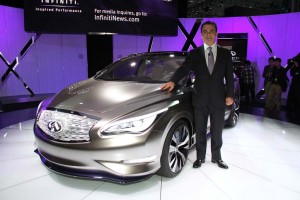Even as demand for its little Leaf battery-electric vehicle begins to gain momentum, Nissan has temporarily pulled the plug on plans to bring the Infiniti LE to market, though sources tell TheDetroitBureau.com that the luxury electric vehicle is still very much part of the maker’s mid-term plans.
The challenge, it seems, is to come up with the sort of improvements in range and performance – as well as the requisite upscale niceties, such as leather seats – that would make the Infiniti more than just a gussied-up Leaf. Nissan is also watching to see how the market responds to other luxury battery cars, notably including the new BMW “i” models, as well as the more expensive Tesla Model S.
“The car is still planned but I don’t think we’re in any rush to bring the car to market,” said a ranking source closely connected to Nissan’s battery car program.
While he noted the growth of the overall market for electric propulsion, the source acknowledged it is not coming “as rapidly as we initially thought,” adding that “we need to get the mass market to grow before luxury buyers accept the technology.”
Even before the production version of the Nissan Leaf came to market in late 2010, CEO Carlos Ghosn had suggested the maker – along with its French alliance partner Renault — would eventually offer a wide range of battery-electric vehicles. Indeed, Nissan is actively working up a battery microcar for the European market based on the quirky little Renault Twizy.
The Infiniti brand has been hinting it would also get into the electric vehicle market for several years. During a conversation at the 2011 L.A. Auto Show, Nissan’s battery car czar Andy Palmer told TheDetroitBureau.com that a then-unidentified model would join the luxury marque’s line-up in 2015, adding that its performance and range “will be as good as Leaf, if not better.”
(Mercedes-Benz planning plug-in version of new S-Class. Click Here for the full story.)
The maker showed what it had in mind months later when the Infiniti LE concept made its debut at the 2012 New York Auto Show. At the introduction, brand officials suggested the luxury battery car would be ready for market in two years, though the timeline soon slipped to 2015.
For the moment, no hard date is on the Infiniti product schedule for the LE, though a source suggested that the goal is “probably sometime in the ’15 to ’16 timeframe.”
The work on the LE is virtually complete, it appears, notably down to basic styling details that could wind up having to be updated if the electric vehicle is pushed back too long. The big gap is where the battery is supposed to plug into the Infiniti LE.
Nissan claims to have made significant improvements in the lithium-ion chemistry it uses in the Leaf, especially in the battery packs that are now being produced at a second plant that opened in Smyrna, Tennessee late in 2012. But in Silicon Valley lingo the latest battery might be dubbed version 1.5.
What Nissan wants, apparently, would be lithium v2 or beyond to make a truly appealing Infiniti LE, “a big leap in terms of cost, range and performance,” the source explained. “And if you’re going to put a new product like the Infiniti LE out there, you will want to do it when the big leap occurs.”
(New Nissan program will let Leaf owners upgrade to newer, more powerful batteries. Click Here.)
Nissan is by no means the only maker looking for that next-gen battery, a lithium formulation that BMW officials recently suggested could result in as much as four times the energy density as existing “advanced batteries.” There are plenty of skeptics, however, who question just how soon that will occur.
But while a select group of mainstream buyers might be willing to accept the trade-offs of today’s batteries – mediocre performance and generally less than 100 miles range per charge – luxury buyers seem less than willing to settle for such concessions. Significantly, Tesla Model S buyers have flocked to the mid- and long-range versions of that sedan, despite a price tag that can push from $70,000 to more than $100,000. In fact, Tesla recently abandoned the lowest-priced, most limited-range Model S.
The problem with the remaining versions is that they require a lot of costly batteries. The general consensus – wishful thinking, if you prefer – is that battery prices will come down sharply even as chemists figure out how to pack more punch into a smaller, lighter package.
In the original incarnation, the Infiniti LE had a 24 kilowatt-hour lithium battery driving a 100 kw electric motor capable of producing 134 horsepower and 240 pound-feet of torque. Expect that whatever – whenever – reached market will deliver even better performance, Nissan insiders stressed, and markedly longer range.
(New super-fast charging system could boost demand for battery vehicles. For more, Click Here.)


Probalaly waiting forever as it’s [pretty difficult to sell impractical EVs to most educated consumers.